So let's discuss my first one. SO I have a question to ask before we get to the meat of our situation. What makes horror compelling? How does something so visceral ... so grotesque... so utterly unnerving get so much of our attention, in both the Halloween season and out? Well, there have been some reasons why. One is The Paradox of Horror as presented by Noel Carroll
 |
| (Cover of The Philosophy of Horror with the Grotesque Saturn Eating his Children painting) |
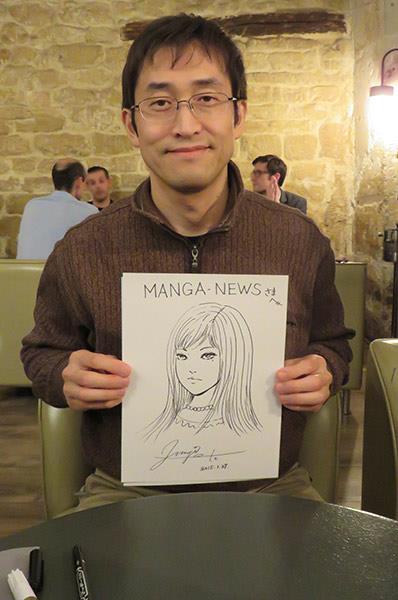 |
| (Ladies and Gentlemen, Meet Junji Ito, My first Fragment of Horror) |
This is the Manga Artist and Writer Junji Ito. A Pioneer and creator in making his own style of horror. It's a interesting mesh and combination of horror techniques from people like H.P. Lovecraft with Spectacle Horror and taking elements of Body Horror from people like David Cronenberg and Surrealist/Monster Horror from H. R. Giger, the creator of Alien. His style is the combination of the words I mentioned for horror. Visceral, Unnatural, and Grotesque. And to make his fame even more infamous, he is collaborating with Hideo Kojima and Guillermo del Toro for Death Stranding, the video game they have collaborated upon since Silent Hills was canceled. In fact, one important detail that stems from such hyperrealistic depictions of body horror in his works stems from his work as a dental assistant while also inking his own manga shorts to Manga Papers.
Now this article will be dedicated to 4 of his stories that I find best detail the psychological and body horror elements. I have the look at "The Library of Illusions", the "Ribs Woman", "The Enigma at Amigara Fault" (Please click on them in order so you can read the stories and have an extra step into understanding his world and also, it wouldn't be fun to analyze his work if we don't read it right?) and the only long story to be considered a novel Uzumaki. These stories I have chosen have been ones I have read and researched as well as have gotten with my sources to help with the stories! But to let you guys know, about two paragraphs will be dedicated to a simple summary for refreshment and I'll go into what makes these stories tick as well as what makes them pretty profound in Ito's themes and common tropes.
 |
| (The cover page of Library of Illusions by Junji Ito) |
So in this little yarn, a young couple, newlyweds, are living in the husbands family house. The husband, Goro, inherited a massive library owned by his parents, 150,000 books of all kinds inside with first editions galore and has preserved them wonderfully. When two books disappear, both his parents favorites, he freaks out and Goro and his wife, Koko, search for them. But then he shows up with both love and affection and later clawed and scared when he claims the two books came to life as personified people affecting him differently with his mothers favorite book, Wintertime for Rene, symbolizes the joy and happiness Goro had with his stable family before his mother divorced his father. But his father's story is a psychological monster horror called Hellskin, and Goro's father would abuse his son every night with reading passages.
After fighting the ghosts of his past, and the books, with reciting their respective books back to them, Goro wants to make extra sure that he never loses a book again. But how does he manage such a feat when he organized and memorized the location of each book? By reading all 150,000. Encyclopedias, Atlases, Horror, Fantasy, Dictionaries, Histories, ... all become part of his mind. But as soon as he starts this mission, he already descends further into insanity, a fear his wife was constantly noticing with his neglect upon himself and her. But now once he finishes his goal of all 150,000, he has completely, lost his psychological/mental humanity. His obsession consumed, he is now at the mercy of his library, reading and reciting knowledge repetitively but normal speech patters and remembering his own name and wife are foreign to him. Trying to make sure the library doesn't consume him, Koko burns the library. However, Goro stays behind and is burned to death along with the library his family preserved. But now that the police arrive, Koko explains the unbelievable accounts and even says that the only surviving relative is Goro's father in the hospital, and in the final panel, we see what could've happened to Goro, a shell of a lost man, with only a library obsession holding him together.
 |
| (Goro and Koko are about to be stalked and worse with Hellfire on the loose) |
So while you're digesting the imagery here, you've noticed the worse that Ito has done with inking his stories is the creepy Hellfire with his shriveled face and the father who looks pretty similar to the book he used to abuse his son. As I said earlier, this is but a taste of what's to come but I wanted to suggest this more for the psychological horror than the monster horror. As a voracious reader in my past, (and sometimes today) reading this story affected me more than usual, especially as an analyst and a reviewer. And using the books as a obsessive way into insanity makes it more compelling on my end but why? Well, it's in part of Ito's philosophy on horror. When Ito makes a story, he focuses on a mundane event or item in life in general, usually with a positive connotation like with book reading for example, and turns it on its head for the madness and show to begin.
With Ito's work on The Library of Illusions, we see the simple and enjoyable task of reading a book, and many of us love a good story, and takes it further with making it a task that could lead to insanity with pursuing knowledge, even if it is to destroy psychological monsters from your parents favorite books, just with how Ito makes Obsession lead to Insanity. But that draws us in because of how Goro is falling into the spiral of madness. Goro attempts to fight against his monsters by pulling further into the void and thus he becomes it, enraptured and becomingly enamored by it. And this is an important aspect of Ito's work that comes from his big influence, Lovecraft,: the spectacle story.
 |
| (Goro listening to his own madness and beginning to lose both identity and sanity.) |
The spectacle story isn't like a traditional narrative due to how the main characters aren't fully dimensional and are caricatures. We know nothing of backgrounds, personality traits other than general madness from Goro and concern from Koko, and even their looks, and we see this a lot in Ito's works, are very generally plain and simplistic. But this element from Lovecraft is done paradoxically, making us ever enamored into the story. And maybe it's for the better that we don't get too sympathetic with our characters. If we do, once they die, we have no interest in the story anymore. The connection is gone. But with the spectacle story, we get the opposite for the spectacle in of itself is what draws us closer to each characters fate, and luckily Koko is one of the lucky characters for many of Ito's characters often must succumb to their fates of punishment, insanity, torture, or even death (and it's usually a death that rivals the fate worse than death).
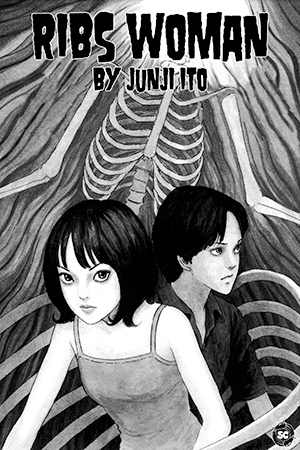 |
| (The Title Art Picture for The Ribs Woman story by Ito. The two protagonists, Yuki and her brother Keisuke) |
"The Ribs Woman" features more of the body horror elements that many fans of Ito expect and the tale is as mysterious and vile as the titular character herself. While also being an urban horror myth style narrative, the "Ribs Woman" also adds another element of Ito's work, social commentary. But this commentary, though predominantly applicable to Japan, has some parallels to even the West's issues.
In the Ribs Woman, Yuki is jealous of her brother, Keisuke's girlfriend Ruriko. She loves her but she's jealous about how she has the perfect frame and decides to have cosmetic surgery to remove her lower ribs to have a more appealing frame. A couple of nights after her meet up with a specialist, Rumiko keeps claiming to hear a mysteriously creepy song from somewhere, unlike any instrument she's heard but stalking and horrifying her. As they follow the sounds, Yuki and Rumiko lead the way, Keisuke hears nothing but tags along for protection, to the park and find a mysterious woman playing a strange harp with one string and bent weirdly. She laughs and disappears but they find that the peculiar harp is a rib bone with piano wire tied to plunk it. Rumiko destroys the rib and makes sure that her boyfriend and sister never tell about this strange occurrence. But after she destroys the rib, the next day she doesn't appear at school and it would be a couple of days later that Rumiko would be found dead with all her ribs taken out of her.
Despite all the shock to her, Yuki still goes to her specialist and he reveals the revelation that he was the one who help with Ruriko's rib removal surgery, thus giving her the new body frame. But he also mentions, quite oddly about another patient he had, his first ever and his first failure apparently. Yuki is pleased with her new body and look but it's not to soon when she hears the music again. Yuki travels alone to find the mysterious harp player. This time she reveals the new rib harp she's playing is Yuki's own, just like when she played with Ruriko's earlier. But then she reveals her purpose and nature for attracting them both with a swan song. The titular Ribs Woman opens her blouse to reveal a mesh of Rumiko's rib bones and piano wires that disturbingly turned her into a human harp. Calling out to the doctor who helped Yuki, the Ribs Woman wants Yuki's ribs inside her body. Complying he agrees and Yuki is nearly killed but Keisuke finally comes to her rescue and the doctor is arrested. But the Ribs Woman is still at large and if you listen on eerie Tokyo Nights, you can hear her demented rib harp play out.
 |
| (The intertwined ribs of the Ribs Woman) |
Hehehe. So this tale now goes into the elements of Ito's hard work and hyper-realistic detail when it comes to his body horror. That rib cage she has sure does scare one out of their skin. (Hopefully once you're out of it, she doesn't try to steal your ribs ladies.) The story has elements of urban legend, kind of similar to a more modern take on horror, the Creepypasta tales of now. The tales are kind of similar to spectacle stories of Lovecraft, with the monster and or the event in question being the similar circumstances of leading our readers into the abyss of horror. But it also goes deeper with social commentary, mostly dealing with Japan's issues on beauty culture.
For in the manga, Yuki so desperately wants to have a thinner waist and thinks that removing her rib bones are the way to go. Now doubt a foil to our Ribs Woman, but instead of going obsessive to murder other women for their lovely ribs, Yuki wants a gratification and recognition of beauty on a tamer level. In fact, some of Ito's works do feature social commentary and warning through his stories but some are interpretive. One that I won't go into but you may read for your own terror is The Hanging Balloons, many have used it as a metaphor for Japans growing problem with Suicide. And those who know the main issues of the Japanese Culture of Collective Harmony vs. Individual Cohesion as well as overwork stress, and any form of dishonoring has lead people to commit a horrible act and is a huge blight that Japan still deals with and tries to solve. But going back to the beauty metaphor of Ribs Woman, in Japan, there is a constant cultural critique of beauty and how it should be applied to young women and mothers. The popular Kawaii (cute) culture has been such a problem with young ladies and mothers with being adorable from all parts of society. It's a slight parallel but pretty potent if you know the social news and issues of Japanese culture.
Ito himself, with his reclusive nature, brings all kinds of things to the table with the social parts of his tales. It's not always prevalent like with other stories like the upcoming Uzumaki, "The Circus is Here", "Bubble Blood Bushes", and "The Beautiful Boy at the Crossroads." But all still feature the common trope of taking the mundane and everyday and spinning it on it's head into a horror story. In fact, Amigara Fault deals with another common occurrence in Japan, as well as here in my native California, Earthquakes.
 |
| (Cover Photo for "The Enigma at Amigara Fault") |
The story focuses on Owaki, a young boy (featured on the cover picture) and Yoshida (the girl on the cover behind him) as they both go to Amigara Fault. However, their small little curiosity of the fault get smacked into dark implications as Yoshida explains how she sees her hole in the fault, and many holes are there which has gotten Japan's Geological Society investigating why the peculiar human-shaped holes are there. Following a dream Owaki has, it's inferred though not fully that the people who come to Amigara are all supposed to be into this fate and go into their holes and day by passing day, more and more people break down into insanity as some try to pry them away from the holes but they all exclaim the same thing after they strip to their underwear. "This is my hole!"
Hoping to get past this nightmare, Owaki and Yoshida room together, the last ditch effort to fight the impulse and struggle for survival. But when Yoshida disappears, Owaki discovers she has allowed instinct and her own negative thoughts to pervade her. Depressed, he drops his flashlight and in an even more disturbing and fated response, the light flashes onto something that looks like it could be his shadow; his own personal hole. Owaki is also fated to join the others and thus he slips right into the abyss of the hole. Months after the geologists discover the back of the fault but what protrudes from the holes is mentally scaring to them as they see the fate of the humans who went inside, their bodies contorted and crushed by the fault lines now a very far cry from their human selves.
| (One of the fated people about to enter his hole) |
The "Enigma at Amigara Fault" focuses on the horrific body horror at the end similar to how "Library of Illusions" presents itself but with a twist on how deformed the bodies become. Physical bodies now deformed thanks to a curse that made reincarnated people go inside to be tortured. In fact, it should be noted that the word Amigara comes from two Japanese words meaning Empty Shell, reflecting their newfound loss. But this is where interpretation is a bit more interpretive as to why and what could the story possibly tell. As I mentioned in The "Ribs Woman" not every one of the Ito stories has a definite interpretation, such as the social commentary of the destructive powers of the beauty industry and self image. And some like "Library of Illusions" are just pure spectacle. No deep analysis or message really there other than to psychologically question our own sanity. But in the story, we see the struggle of Yoshida and Owaki with trying to bring meaning into their lives.
Yoshida has been neglected by both family and friends. Parents barely showed attention, friends didn't pay too much mind. Her depression leads her to a symbolic suicide through Amigara Fault. Although it seems like all are alive and conscious though they are hardly recognized as human. In fact, this story uses her, Owaki, and other minor characters of the story to portray a concept from Freudian psychoanalysis, Eros and Thanatos. (I'm not a psychologist so this is a brief and general explanation and we won't go into the Id, Ego, and Superego much when talking of these two drives.)
Eros is the Life Drive of Freudian psychosis. Named after the Greek equivalent to Cupid, Eros Drive focuses upon life driving and survival instincts. Sex, Food, Family, Philosophy, Religion, all these and more supplement the life drive in the promotion of making humans more rational and life affirming. Such is necessary for them to live and flourish and create something of themselves. We see this with Yoshida and Owaki's romantic attraction and when he covers the hole of Yoshida so she doesn't get called into it. But also when they spend the night together, one might look to sexual and romantic confirmation of the two being together in surviving their ordeal.
 |
| (The Final Panels of the Story with the newly metaphorical zombie coming out of the crushed faults of Amigara.) |
 |
| (Cover of the Uzumaki Special Complete Edition featuring the Hair fight scene in the manga) |
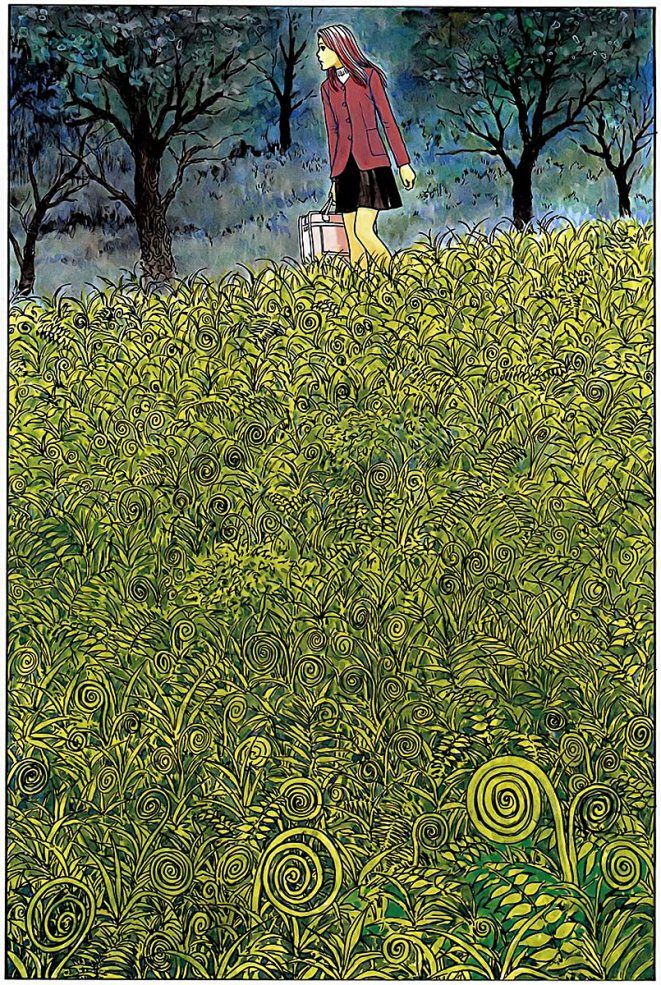 |
| (The First and one of the few Color Inked Pages of the Uzumaki Manga. Note the foreshadowing in the grass.) |
Yup. All those spirals. All in the grass and that's but the tip of this iceberg. You're probably wondering how does he turn a spiral upon its head. Well maybe hear what he says about the inspiration for choosing the spiral for the central driving force of the story. To summarize, he noted how in traditional Japanese media, the spiral is a general symbol of rosy cheeks and happiness. In general, its a positive force.
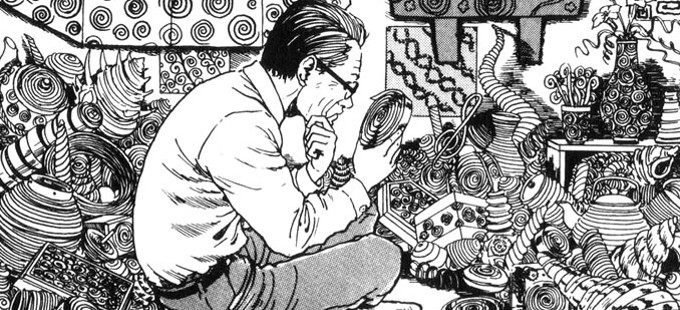 |
| (Shuichi's father, a pivotal character, collects all the strange and unnatural phenomena of the spiral from sculptures, nature, pottery, etc.) |
 |
| (The Medusa Spiral effecting one of the girls in Uzumaki.) |
Every Chapter in the story focuses upon two protagonists, lovers Kyrie (pronounced Kyr-E-eh) and Shuichi (pronounced Shoe-E-Chi). Kyrie wishes to leave her seaside town of Kurozu-cho, (pronounced Kuro-Zoo-Cho) a seaside town in Japan. (This is where Lovecrafts similaries come in for Lovecraft made most of his stories in New England and the story The Shadow over Innsmouth is a parallel to Kurozu-cho's seaside locale from the town of Innsmouth, Massachusetts.) Both of them discover more and more about the phenomena of the spiral from Shuichi's father and it seems like every, new natural and human made spirals surround the city until the intents and purpose of the Spiral's grand plan unravels.
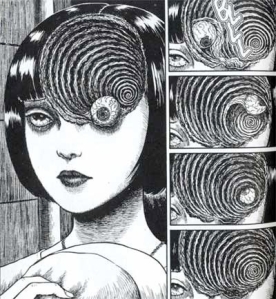 |
| (The Spiral Absorbs one unfortunate girl. Even looking at this makes me both nauseous, dizzy, and creepily disoriented.) |
And As I said with making a parallel in the episodic style of the Inferno, it feels like we ourselves are like Dante, with Kyrie being our Vergil and going down the timeline with a new punishment being made around the spiral in some way. Shuichi's father loves the obsession he has with the spiral he contorts his body into it as his final wish. Shuichi's mother sees it everywhere and tries to get rid of the spiral (Cutting finger and footprints off) once and for all but it still haunts her even til death (I'm gonna let you read Chapter Two: The Spiral Obsession to see what I mean). Natural Disasters like Hurricanes and Whirlpools cause the attacks and deaths of people. Hair is tangled into Medusa like control, the spiral can literally eat someone and disappear in a few moments. People turn into snails slowly and painfully and anyone who messes with the newly transformed snails gets turned into them. Pregnancy isn't even safe and vampiric mothers take corkscrews to screw out holes and eat the blood of all types of people. And people rip themselves out of their bodies, with their spines turned into coils and springs to hop around.
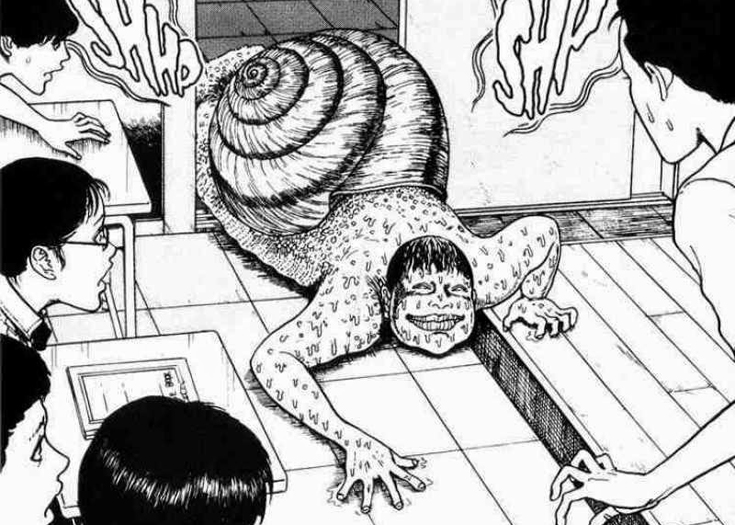
Note how all of these use the spiral in different ways. A new punishment for each new story. And each picture you see incorporates that feel. Body and Psychological Horror are used to the up-tenth to display the Lovecraftian turn of Ito's masterpiece. Ito creative uses for subverting the spiral have been well done to accomplish his inversion goal: unique, creepy, and psychologically haunting. But this goes with all his stories. Maybe they don't require the same attention Uzuamki or Amigara needs for body horror. Maybe they don't always have a more veiled message like "The Hanging Balloons" or "Ribs Woman." But all in all, Ito has allowed us into his world of fatalistic and maddened protagonists as the spectacles of their lives either haunt them or have already killed them.
Thank you for reading and enjoying my first Fragment of Horror. But don't leave so soon. I have 12 more articles for you to enjoy and I hope I do my best in promoting them. So comes to the end of Fragment 1: Junji Ito
And for further looks as well as some great videos/works cited for me:
Check out two of my favorite YouTube Channels: Ragnar Rox and Tale Foundry
RagnarRox is an analytic media YouTuber focusing on horror in video games and movies. Check out some of his work on I Have no Mouth and I Must Scream the game and his Monsters of the Week Series for some great content. He's also done these two great videos on Junji Ito that have been so well polished.
Junji Ito: Spiral into Horror
Junji Ito's Amigara Fault & The Horror of Compulsion
Tale Foundry, on the other hand is focused on analyzing the tropes of story styles and for beginner authors like me, I love the research and focus for new types of stories from examining Ito and Creepypasta to Weird Fiction and Celtic Lore. And each analysis comes a short story written by the team to listen and enjoy.
Ito Videos
Do Junji Ito's Characters Actually Matter?
3 Ways Junji Ito Disturbs Us
Sillouhettes: A Short Story
And check out my last suggestion and video
How Media Scares Us: The Work of Junji Ito
No comments:
Post a Comment